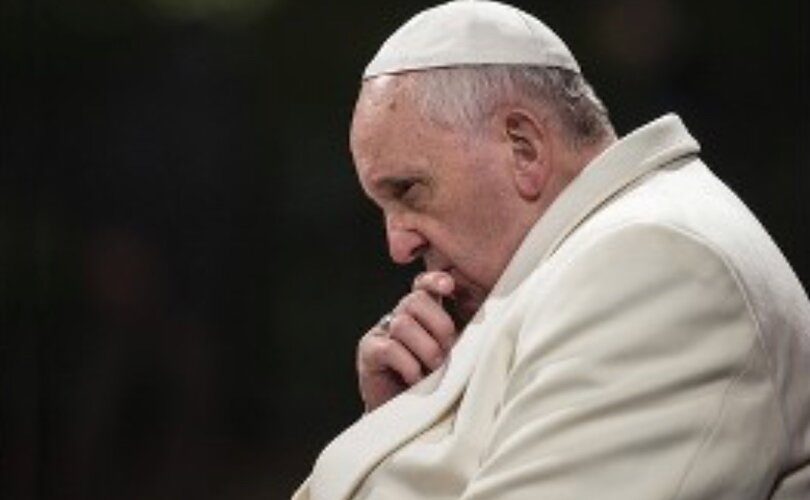Several seminal studies of Francis – such as Henry Sire’s The Dictator Pope and Austen Ivereigh’s The Great Reformer – have highlighted the biographical and psychological reasons why the pope may be trying to change the Catholic Church. Now, there is a formidable new book delving into the historical reasons why it is unsurprising that we ended up with the subversive Francis pontificate.
The book is by Jean-Pierre Moreau, and it is called The Synodal Pope. Moreau’s main point is that a revolutionary wind blew through the world from which Jorge Bergoglio came. “Father Jorge Mario Bergoglio is the product of the Cuban revolution, the Second Vatican Council, Father [Pedro] Arrupe’s reform of the Society of Jesus, and the corresponding revolutions throughout Latin America,” writes Moreau.
Francis, in other words, has been profoundly shaped by a ragtag group of renegades, revolutionaries, and iconoclasts. Here is an abridged guide to some of the key players discussed by Moreau’s work.
The Modernists of Vatican II
As Moreau explains, the Second Vatican Council (1962-1965) unleashed the often-underground forces of Modernism. Put simply, Modernists wanted to “update” the Church to suit the historical moment. They wanted the “historicization” of faith, dogma, morality, and discipline. According to Moreau, European Modernists not only circulated their ideas at the council but also collaborated with and trained key figures from Latin America.
To take one example of Modernist plotting, toward the end of the council, a group of some forty bishops met on the sidelines to sign the “Pact of the Catacombs.” This act, says Moreau, “gave birth to the Revolutionary Church of Latin America and coined the slogan ‘The Church of the poor.'” Invoking the poor, revolutionaries could now subvert an institutional church painted as too proud, rich, and ideologically oppressive.
Enter Pope Francis. When Francis, newly elected, stepped onto St. Peter’s loggia, he refused to wear various traditional symbols of his office. Moreau says that Francis, in this way, consciously paid homage to the Pact of the Catacombs, “which forbids wearing rich ornaments for the sake of the poor.”
Further showcasing this pontificate’s historical consciousness, Francis presided over an Amazon synod that facilitated, at one point, a “renewal” of the Pact of Catacombs. In this way, Francis further identified himself as the heir to the revolutionary energy of Vatican II’s Modernists.
Fr. Pedro Arrupe’s Jesuits
According to Moreau, an “army” of Jesuits guided the implementation of the revolutionary spirit unbottled by Vatican II. They were led by Father Pedro Arrupe, the prophet of the “Church of Tomorrow.”
In a decisive move, Arrupe once appointed Bergoglio to be the youngest provincial of the Argentinian Jesuits. Bergoglio, as Moreau shows, would return the favor by adopting Arrupe as the intellectual father of his pontificate.
“The eight hundred pages of Father Arrupe’s collected works are no more than a dramatization of the need to adapt to history,” says Moreau. For instance, Arrupe wanted catechisms to stop offering “complete, strict and orthodox definitions, because these could lead to an aristocratic and involutionary form.”
Compare this to what Cardinal Victor Manuel Fernández once said of the then Archbishop Bergoglio: “[He] always insisted that parish priests be merciful and not defend rigid morality or strict ecclesial practices, and that they not complicate people’s lives with complex norms authoritatively handed down from above.”
Whether complaining of an “aristocratic” or an “authoritative” form, both statements portray the structure “from above” as something to be circumvented. Fernández – Francis’s ghostwriter and handpicked head of the Church’s doctrinal office – recently showed what this crusade means in practice, unveiling this pontificate’s liberal stance toward blessings for same-sex couples.
The Latin American liberation theorists
As Moreau shows with encyclopedic force, the post-conciliar spirit of revolution lived on in a dizzying number of Latin American liberation theorists. According to Moreau, key thinkers modeled their enterprise on the French Revolution of 1789, hoping that the “people” would “overthrow the tyranny of princes and popes.”
Bergoglio, in the 1970s and beyond, “had frequent dealings” with many of the liberation theorists whom Moreau lists. All in all, Moreau categorizes this period as one of revolutionary efflorescence, in which a thousand writings on liberation theology were already identified by 1974.
“This revolutionary effervescence,” Morea says, “was comparable to that which preceded the French Revolution. All the key protagonists were preparing for the fray. When Pope Francis was elected, everything was in place.”
Indeed it was. Hence, for instance, the quick papal favor shown to Leonardo Boff, a liberation theorist who left the priesthood and entered a marital relationship with a Marxist after being disciplined by the Church’s doctrinal office in the 1980s. Boff believes, among other things, that “our species” is a “true Satan of the Earth” and that we should strive for a “universal religion” whose “supreme value” is the preservation of “Gaia,” Mother Earth.
Boff helped inspire both the Amazon synod and Francis’s Laudato Si’ (“Wait, that is Boff!” various people remarked after reading the latter).
With mentors and allies like these, the Francis pontificate is sure to have more surprises up its sleeve. We’re on a wild train ride, and to shunt it we must grapple with the past—working to understand the hectic, revolutionary world from which Francis came.
The Synodal Pope: The True Story of the Theology and Politics of Pope Francis by Jean-Pierre Moreau (416 pages, translated from French by Jeanne Smits) can be purchased from Tan Books in both hardback, eBook, and MP3 audio download forms.
READ: Archbishop Aguer remembers two Argentine Catholics killed by radical revolutionaries

